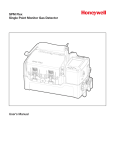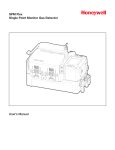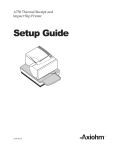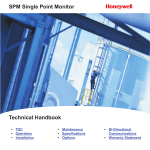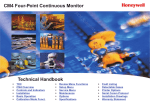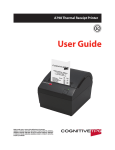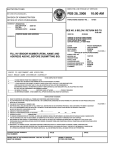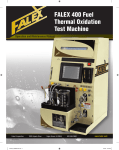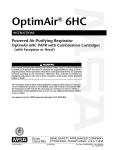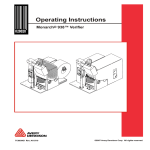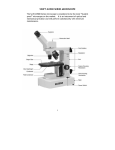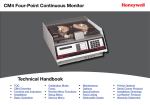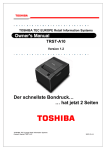Download Honeywell Analytics SPM Flex Single Point Tape
Transcript
SPM Flex Single Point Monitor Gas Detector User’s Manual SPM Flex Gas Detector Introduction���������������������������������������������������������������������������������������������������������������� 5 Safety Information�������������������������������������������������������������������������������������������������� 6 Contact Information������������������������������������������������������������������������������������������������ 7 Glossary���������������������������������������������������������������������������������������������������������������������� 8 Product Overview������������������������������������������������������������������������������������������������������� 9 Battery operation�������������������������������������������������������������������������������������������������� 10 The handle (portable model)�������������������������������������������������������������������������������� 11 Opening the cover������������������������������������������������������������������������������������������������ 11 Main power rocker switch������������������������������������������������������������������������������������ 12 Turning the detector on and off���������������������������������������������������������������������������� 13 Navigation������������������������������������������������������������������������������������������������������������� 14 Menu Map������������������������������������������������������������������������������������������������������������� 15 Loading a Chemcassette cartridge���������������������������������������������������������������������� 17 Wiring and tubing����������������������������������������������������������������������������������������������������� 19 Typical fixed installation topologies��������������������������������������������������������������������� 19 Wiring diagrams���������������������������������������������������������������������������������������������������� 21 4-20 mA wiring������������������������������������������������������������������������������������������������������ 22 Modbus register definitions���������������������������������������������������������������������������������� 24 Setup������������������������������������������������������������������������������������������������������������������������� 26 Installation drawing����������������������������������������������������������������������������������������������� 26 Mounting options�������������������������������������������������������������������������������������������������� 26 Dimensions������������������������������������������������������������������������������������������������������������ 27 Standard mounting bracket���������������������������������������������������������������������������������� 28 Backward-compatible mounting bracket������������������������������������������������������������ 29 In-line filters����������������������������������������������������������������������������������������������������������� 30 Optional sampling wand��������������������������������������������������������������������������������������� 30 Attaching the shoulder strap�������������������������������������������������������������������������������� 31 Operation ����������������������������������������������������������������������������������������������������������������� 32 Controls����������������������������������������������������������������������������������������������������������������� 32 Setup menu����������������������������������������������������������������������������������������������������������� 38 Troubleshooting�������������������������������������������������������������������������������������������������������� 42 Maintenance������������������������������������������������������������������������������������������������������������� 46 Storing the detector���������������������������������������������������������������������������������������������� 49 Recycling��������������������������������������������������������������������������������������������������������������� 49 Storing Chemcassette® cartridges����������������������������������������������������������������������� 49 Labels������������������������������������������������������������������������������������������������������������������������ 50 Detectable Gases����������������������������������������������������������������������������������������������������� 51 Specifications ���������������������������������������������������������������������������������������������������������� 52 Accessories and Parts��������������������������������������������������������������������������������������������� 53 Certifications������������������������������������������������������������������������������������������������������������ 56 Warranties����������������������������������������������������������������������������������������������������������������� 57 SPM Flex warranty������������������������������������������������������������������������������������������������ 57 Chemcassette® cartridge warranty���������������������������������������������������������������������� 57 Index������������������������������������������������������������������������������������������������������������������������� 60 3 SPM Flex Gas Detector 4 SPM Flex Gas Detector Introduction The SPM Flex gas detector is an extractive gas monitoring system that draws gas samples locally or from a remote point to a Chemcassette® tape-based optical gas detection system. A wide range of toxic gas Chemcassette cartridges are available that enable detection of gases used or generated in semiconductor manufacturing and industrial environments. The SPM Flex gas detector, available in wall mounted and portable versions, locally displays gas concentration, alarm, fault and status information via its backlit color LCD and LEDs. A simple to use 4-button keypad adjacent to the display provides the ability to set-up, review, operate and make changes to the detector’s configuration. The intuitive display and menu structure are designed to require minimal training. The SPM Flex has a local audio alarm with user-configurable output levels. The detector can be used both indoors and outdoors in a wide range of weather conditions. The detector has flexible power and communications capabilities. These include 3 on-board relays, 4-20 mA analog output and Modbus/TCP outputs for signal and service connectivity. The gas detector is equipped with a USB port for configuration-sharing firmware updates and data downloads. For web-enabled devices, web pages are available via the Ethernet port. Standard operation conditions The SPM Flex gas detector is designed for use in temperatures between 32ºF and 104ºF (0ºC and 40ºC) and relative humidities between 0 and 100% (the relative humidities are limited by tape and calibration). The sample line will require additional hardware to remove moisture in high relative humidity conditions where condensing may occur (the sample must be non-condensing). Dry conditions may require humidification. High-altitude applications The SPM Flex pump is optimized for operation at altitudes between –1000 feet (–305 meters) and 3000 ft. (945 m) above sea level. At altitudes above 3,000 ft. (915 m), up to a maximum of 6,000 ft. (1,830 m), contact Honeywell Analytics for calibration. (At 6,000 feet, pump capacity is reduced 18% and a flow-system adjustment to the bypass valve is required. This must be performed by a Honeywell Analytics certified technician. Contact Customer Service.) 5 SPM Flex Gas Detector Safety Information ! DANGER Danger notices contain information that could prevent death or serious injury. ! WARNING Warnings contain information that could prevent injury or equipment damage. ! CAUTION Caution notices contain information that could prevent equipment damage. NOTE Notes contain helpful information. 6 SPM Flex Gas Detector Contact Information Find out more: www.honeywellanalytics.com Americas Honeywell Analytics 405 Barclay Boulevard Lincolnshire, IL 60069 Tel: +1 847 955 8200 Toll free: +1 800 538 0363 Fax: +1 847 955 8208 [email protected] Europe, Middle East, and Africa Life Safety Distribution AG Javastrasse 2 8604 Hegnau Switzerland Tel: +41 (0)44 943 4300 Fax: +41 (0)44 943 4398 [email protected] Asia Pacific Honeywell Analytics Asia Pacific Co., Ltd. #701 Kolon Science Valley (1) 43 Digital-Ro 34-Gil, Guro-Gu Seoul, 152-729 Korea Tel: +82 2 6909 0321 VOIP: +8 5401 0321 [email protected] Technical Services [email protected] www.honeywell.com 7 SPM Flex Gas Detector Glossary Term Description An analog communication method using a current loop to indicate concentration readings and fault status. An easy-to-install case that carries Honeywell’s Chemcassette® cartridge Chemcassette tape. Cartridges are specific to different gas types/families. Commonly used network technology for wired Local Ethernet Area Networks. The unit is actively monitoring the specified gas or In monitor family of gases When configured, the SPM Flex will hold the alarm or Latching alarm or fault fault status active until the user performs an alarm/ fault reset. Liquid Crystal Display LCD LED Light Emitting Diode Communications protocol running over Ethernet that Modbus TCP is commonly used for communicating with industrial devices. An alert in which the SPM Flex will reset Non-latching alarm or automatically when the condition is no longer fault present (i.e., the detector does not have to be reset by the user). Out of monitor The detector is on but idle An electrical-operation output switch that can be Relay used to indicate the presence of alarm and fault conditions. Time Weighted Average, the average exposure to a harmful gas, usually calculated over a period of eight TWA hours (a the typical workday). Universal Serial Bus is an industry standard communications protocol and bus that is commonly USB available on personal computers. Volts of Direct Current VDC 4-20 mA loop 8 SPM Flex Gas Detector Product Overview The SPM Flex gas detector is available in two configurations, portable and fixed. The portable model is equipped with a handle assembly and a shoulder strap. The fixed unit is supplied with a mounting bracket. If replacing an old SPM detector, a retrofit bracket is available (these are shown on pages 28 and 29). All units are supplied with a power adaptor1 and cable, a CD containing the user manual, and a printed quick start guide. ! WARNING Operate and service the SPM Flex gas detector only as specified in this manual and the accompanying quick start guide. Failure to do so may impair the protection provided by the detector and may also void the warranty. Initial setup Prior to use, the detector requires some minimal setup: • Unpack the unit (save the packaging to re-use for service requests). • Read the quick start guide and this manual. • Install a filter at the unit or at the end of a sample line Portable detectors • Connect the power adaptor (in a dry, indoor location) • Charge for at least 4 hours (the detector can be used while being charged) • Open the detector’s cover • Remove the rocker switch cover • Turn the rocker switch to the on position • Replace the rocker switch cover • Remove the paper optics card from the gate (save the card for later use) • Load a chemcassette • Configure the detector and begin to monitor (see pages 15-16 for basic display usage) • See detailed Operation (pages 32-41) and Optional accessories (pages 53-55) Fixed detectors • Install the wall-mount bracket and mount the detector to it (see pages 28-29) • Wire in accordance with local electrical codes utilizing a trained electrician (see pages 19-25) • Input • Honeywell-supplied power adaptor (indoor, dry location use only) or • 24 VDC power supply • Signal (as desired) • 4-20 mA • Relays • Ethernet • Open the detector’s cover • Remove the rocker switch cover • Turn the rocker switch to the on position • Replace the rocker switch cover • Remove the paper optics card from the gate (save the card for later use) 1 FSP Group Model FSP135-AAAN rated 1 5.62A / 24V (UL Listed QQGQ (E190414)) 9 SPM Flex Gas Detector •Load a Chemcassette cartridge •Configure the detector and begin to monitor (see pages 15-16 for basic display usage) •See detailed Operation (pages 32-41) and Optional accessories (pages 53-55) Additional accessories •External dust filters (required on inlet) •Tubing •Sampling wand •Mating signal connectors for fixed installations The ports of a typical installation is shown in the figure below. Exhaust out port Sample in port Power connector Ethernet connector Relays or 4-20 mA connector Figure 1. terminals and ports Battery operation The SPM Flex gas detector is supplied with a power supply/charger than can connect the detector’s power connection and a standard wall outlet. (Ensure that the correct power cable has been ordered for local operation.) The power supply/ charger is designed for indoor, dry-location use only. The lithium-ion battery pack provides continuous operation of 6+ hours, depending on sampling conditions and unit configuration. The battery’s charge time is typically 4 hours. The detector can be operated while its battery is being charged (this may increase the charge time). Because batteries discharge slowly when not in use, Honeywell Analytics recommends keeping the detector connected to the power supply/ charger when not in use. ! WARNING •The battery is not field-replaceable. Return the unit to Honeywell Analytics if a battery replacement is necessary. •Risk of fire and burns. Do not open, crush, heat above 140ºF (60ºC), or incinerate the battery. Follow manufacturer’s instructions. 10 SPM Flex Gas Detector How to extend battery life Power consumption is optimized to extend battery life when not in monitor mode. In addition, the unit should not be exposed to extreme temperatures which shortens battery life. The time before recharging is required can be extended by taking the detector out of monitor mode when it is not in use. The handle (portable model) The detector can be conveniently carried with the optional handle, which is mounted onto the cover at three locations. If necessary, the handle can be removed by the user by removing two bolts. All of the detector’s functions can be performed with the handle attached. The handle swings out of the way for access to the Chemcassette cartridge area. Opening the cover Figure 2. Opening the detector cover 11 SPM Flex Gas Detector Release the cover by first unscrewing the handle pin. Pivot the handle up as shown in the illustration and push down the four latches (two on each side). The detector cover will then be free to swing open, allowing a Chemcassette cartridge to be inserted or replaced, the power switch to be turned on or off, or the USB data port to be accessed. Main power rocker switch Rocker switch cover Main power rocker switch Figure 3. SPM Flex main power rocker switch After the detector’s cover is open, use a Phillips screwdriver to remove the rocker switch cover. Turn the main power rocker switch to the on position and replace the rocker switch cover. The detector can now be turned on. 12 SPM Flex Gas Detector Turning the detector on and off Press and hold the Power/Cancel button until the green LED begins blinking. The detector will begin a startup sequence that lasts about 30 seconds. The four LEDs provide at-a-glance information about the current state of the detector: LEDs (red, green, yellow, blue) Figure 4. SPM Flex LEDs LED Red Green Yellow Blue solid Description Alarm 1 blinking Alarm 2 blinking The detector is active solid blinking solid Maintenance fault Instrument fault Connected to external power To turn the detector off, press and hold the Power/Cancel button for 5 seconds or select “Power Off” from the menu. 13 SPM Flex Gas Detector Navigation Display Power/Cancel Accept/Select Up arrow Down arrow Figure 5. SPM Flex controls All SPM Flex menus are navigated by the four buttons shown in Figure 5. Pressing either of the arrows or the Accept/Select button will access the menu from the main display screen. The arrows also are used to scroll up and down through lists of options. The Accept/Select button is used to initiate a highlighted option. During navigation, the Power/Cancel button will cancel a command or, when pressed for more than 3 seconds, it will exit to the main display. 14 SPM Flex Gas Detector Menu Map Main Menu Login/Logout Reset Alarms & Faults Reset all Silence audio alarm Monitor Mode Out of Enter monitor mode monitor mode Change Chemcassette Review Mode Event History Chemcassette Gas Settings Network Additional Status Output State Trend/Plot Security Configuration Manager Software Maintenance Inhibit Summary 4-20 mA Current Loop Flow Characterization Open/Close Gate Update Program General Monitoring Latching Outputs Network Optics Verification Simulate Force Relay Setup Test Force 4-20 mA Power Off The SPM Flex detector’s menus are easily navigated. As an example, this is how a user could review the detector’s gas settings when starting from the In Monitor screen: 1. Press the Up Arrow > to return to the Main Menu. 2. Press the Down Arrow 4 times to highlight the Review Mode option. 3. Press the Accept/Select button to enter Review Mode. 4. Press the Up Arrow or Down Arrow until the Gas settings option is highlighted. 5. Press the Accept/Select button to display the Gas Summary. To return to the detector to the In Monitor display, press the Power/Cancel button three times to back out of the Main Menu options. 15 SPM Flex Gas Detector The display Figure 6 shows the elements of the display that will be seen in various situations. Alarm 1/ Instrument Concentration Alarm 2/ Fault trend Inhibit Maintenance indicator Mute indicator Fault Status bar Menu title 15:42:01 15:42:01 2 0 . 123 ppm 5.678 Menu options Main menu Login / Logout Reset alarms/faults 1.234 H2S - Hydrogen Sulfide Monitor mode Change Chemcassette In monitor Gas name Monitor mode Indicator Battery Clock indicator Units Gas concentration Monitor mode indicator Bar graph w/upper, lower alarm limits Highlighted option Scroll bar Figure 6. Elements of typical SPM Flex detector displays The bar graph on the right shows the current concentration relative to the Alarm 1 and Alarm 2 setpoints. (The bar’s range is relative to the alarm levels, not to the full scale of the selected gas). The color of the status bar changes according to the system status (green = OK/ in monitor, yellow = fault, red = alarm, blue = Out of Monitor mode). Display and navigation Under normal operation the LCD and LED display system status, gas concentrations, and alarms. In set-up, review, calibration, and test modes, the LCD shows the relevant menu options and system status bar. The interface is navigated using the four buttons: Control Up arrow Function Scroll up through lists of options Down arrow Scroll down through lists of options Accept/Select Accept or select a highlighted option Power/Cancel Power/Cancel will turn the unit on if it’s in the off state, will exit back to the previous menu level, and will enter Reset mode (quick press), or Power Off mode (long press and hold) from the main display. In the main display mode, the display shows the current gas name and concentration, the monitoring states and faults and/or alarm status, if applicable. 16 SPM Flex Gas Detector Loading a Chemcassette cartridge Close the Chemcassette cartridge door before putting the detector into Monitor mode (this holds the Chemcassette cartridge in place). Take the detector out of Monitor mode before opening the door. NOTE Chemcassette cartridges must be stored according to the manufacturer’s guidelines when not in use. Chemcassette cartridge Take-up spindle Encoder Optics gate card Figure 7. The optics gate card and Chemcassette cartridge 1. If the detector’s handle is installed, release it by unscrewing the thumbscrew. For fixed installations, skip to Step 3. 2. Tilt the handle up as far as possible. 3. Unfasten the latches on the sides of the detector (two on each side) that secure the Chemcassette cartridge access cover. 4. The detector has slotted hinges. Lift up the cover slightly and then open it all the way to the right. 5. Select the Change Chemcassette menu option and follow the on screen instructions. 6. If required, remove the old Chemcassette cartridge. When prompted, snap the new Chemcassette cartridge into place. It will fit in only one orientation. The takeup spindle will “flutter” back and forth to allow easy installation. 7. To close the cover, position it over the base and press so that it contacts the gasket uniformly. 8. Close the latches on the sides of the detector to secure the cover. 17 SPM Flex Gas Detector If there is an error (i.e., the same cartridge was reinserted, the new cartridge has expired, or an unqualified user is attempting to insert a cartridge that detects a different gas than the last one), an error message will be displayed and the installation will be canceled. If the installation is successful, a summary of the current configuration will be displayed and the user can then choose whether to enter Monitor Mode or exit the Change Chemcassette Mode out of monitor. Removing a Chemcassette cartridge 1. 2. 3. 4. Navigate to Maintenance > Open/Close gate. Select “Open Gate.” Remove the cartridge. Select “Close Gate.” Changing the selected gas 1. While out of monitor mode, navigate to Set-up > Monitoring > Gas. 2. Select “Current gas” and pick the desired gas from the selection box 3. Select “Save.” Entering monitor mode From the main menu, navigate to the “Monitor Mode” option and select “Enter monitor mode.” 1. If a Chemcassette cartridge has been installed, the detector will enter Monitor Mode. 2. If a Chemcassette cartridge has not been installed, a user with the necessary passcode can inititate the Chemcassette wizard. Otherwise, the detector will not enter monitor mode. 18 SPM Flex Gas Detector Wiring and tubing Typical fixed installation topologies The SPM Flex gas detector has flexible installation options that allow the user to select the one most suitable for a specific application. The detector is supplied with weather-sealed connectors for power, Ethernet, and communications (for relays or 4-20 mA). Any of the ports can be replaced with appropriate connections in accordance with local codes (allowing the user to wire directly to the terminal block). Install each detector near a dedicated circuit breaker. ! CAUTION • The safety of any system incorporating the SPM Flex gas detector is the responsibility of the assembler of the system. • Position a permanently-installed SPM Flex gas detector so that it does not interfere with access to the dedicated circuit breaker. Electrical connection is made via conduit directly to ports or via the connector (see Figure 1 on page 10). The terminals used are suitable for conductors of 24 to 14 AWG (0.5 to 1.8mm Dia.). The use of 16 AWG (1.5 mm dia.) conductors is recommended. ! CAUTION Use the supplied power adaptor/connector only. (The adaptor is rated for indoor use only.) 19 SPM Flex Gas Detector Ethernet connector P8 P9 NO Relay 2 NO COM NC Relay 1 NO COM NC + Fault COM NC - - + 24 VDC 4-20 mA 4-20 mA connections Input power connections Relay connections top of detector Figure 8. SPM Flex connections Terminal Module The terminal module is located on the main PCB inside the gas detector. All power, relay, and 4-20 mA connections to SPM Flex are made via this module. Wire entry to the terminal module area is via the cable entry/conduit entry located at the top of the detector. This table shows the default wiring configuration for the communication connector when installed by Honeywell Analytics. The relays are labeled for the factory default but the configuration can be modified to have a single alarm and separate faults. Relay Terminal Connections No. Color Assign to Relay 1 2 3 4 5 6 7 8 9 10 Brown Red Orange Yellow Green Blue Purple Gray White Black Alarm2 COM Alarm2 NO NC Alarm1 COM Alarm1 NO NC Fault COM Fault NO NC NC For 4-20 mA wiring, wires 1 through 8 would be disconnected and wires 9 and 10 would be used. Do not run 4-20 mA signals and relay signals in the same cable bundle. 20 SPM Flex Gas Detector Wiring diagrams SPM Flex Controller +VE 24V+ 1 RL Signal 4-20 mA+ 2 Current Flow -VE 24V- 3 Figure 9. 4-20 mA sink wiring diagram SPM Flex Controller +VE Signal 24V+ 1 2 4-20 mA Current Flow RL -VE 3 24V- Figure 10. 4-20 mA source wiring diagram Controller SPM Flex +V1 24V+ +V2 4-20 mA+ -V2 -V1 4-20 mA24V- Figure 11. 4-20 mA isolated wiring diagram 21 SPM Flex Gas Detector 4-20 mA wiring 4-20 mA output is a three-wire connection that is configurable as sink, source, or isolated, as shown in these following figures. Use an Allen wrench to remove the wiring cover for access to the terminals. There must be a 200-600-ohm load on the 4-20 mA line. To ensure adequate resolution to overcome tolerance in the 4-20 mA reading, set the full scale at an appropriate level. The SPM Flex issues a fault if the measured 4-20 mA reading is more than 0.8 mA (5% full scale) off from the expected drive value. jumpers Figure 12. 4-20 mA sink configuration jumpers Figure 13. 4-20 mA source configuration jumpers Figure 14. 4-20 mA isolated configuration 22 SPM Flex Gas Detector Relays The detector is equipped with three relays. Connect the unit as shown in this figure. - + FAULT TERMINALS NO Relay 2 NO COM NC RELAY 2 TERMINALS Relay 1 NO COM NC + Fault COM NC - 24 VDC 4-20 mA RELAY 1 TERMINALS Figure 15. Relay configuration The relays can be wired as normally closed or normally open. It can also be configured as normally energized or normally de-energized via software. NOTE Do not wire relays and 4-20 mA in the same wire bundle. By default, the relays are set to Alarm 1, Alarm 2, and Instrument Fault. 23 SPM Flex Gas Detector Modbus register definitions Register Address/Name 40001 System Status 40002 Lastest Active Fault Code 40003-40004 Reported Concentration 40005-40006 Actual Concentration 40007-40011 Gas Abbreviation 40012 Concentration Display Format Description 0-2 Inhibit State 3 4 Instrument Fault Maintenance Fault 5-6 Alarm State 7 Monitor State 8 Conc Over Fullscale 9-10 Concentration Trend 11 12 13 14 15 16 bit Integer (0 = No fault) 32 bit Float 32 bit Float 9 byte string including terminator 0-1 Alarm 1 Simulation Alarm 2 Simulation Instr. Fault Simulation Maint. Fault Simulation Unused Units 2-3 4-15 32 bit Float 32 bit Float 32 bit Float 32 bit Float Decimal Places Unused Alarm 1 Enabled Alarm 2 Enabled Unused 40023-40024 Alarm 1 Setpoint 40025-40026 Alarm 2 Setpoint 40027-40028 User LDL 40029-40030 4-20 mA Fullscale 40031 Chemcassette Code 40032 Chemcassette Days Remaining 40033 Flow 0 1 2-15 32 bit Float 32 bit Float 32 bit Float 32 bit Float 16 bit Integer 16 bit Integer 16 bit Integer 40034 Battery Level 16 bit Integer 40039 Heartbeat Counter 16 bit Integer (increments once per second) 40013-40014 Gas Table LDL 40015-40016 LAL 40017-40018 TLV 40019-40020 Fullscale 40021 Unused 40022 Alarm Enable 24 Bits Values 0: No Inhibit 1: Inhibit Alarm 2: Inhibit Fault 3: Inhibit Alarm & Fault 4: Inhibit All 1 = Active 1 = Active 0: No Alarm 1: Alarm 1 2: Alarm 2 0: Not Monitoring 1: Monitoring 1 = True 0: Stable 1:Rising 2: Falling 1 = Active 1 = Active 1 = Active 1 = Active 0: PPB 1: PPM 0, 1 or 2 1 = Enabled 1 = Enabled SPM Flex Gas Detector Tubing (optional) Sample and exhaust tubing calculations This table shows the flow rate, tubing length, transport time, and maximum pressure and vacuum at the inlet and exhaust points. Tubing lengths vary among gases. If the pressure or vacuum on the inlet/exhaust lines does not meet the recommended values, the detector may encounter flow faults. The maximum total tubing length (inlet + outlet) is 100 ft. (30 m). Sample Specifications Description Inlet Outlet Value Tubing length, ft. (m) 100 (30) 66 (20) 33 (10) 0 Transport time (sec) 19 13 7 1 Flow rate (cc/min.) 700-1200 (flow is set and controlled per calibration) Tubing OD. in. (mm) 0.25 (6.35) Tubing ID, in. (mm) 0.125 (3.18) Tubing length, ft. (m) 100 (30) Tubing OD, in. (mm) 0.25 (6.35) Tubing ID, in. (mm) 0.188 (4.76) The overall maximum load on the pump between the inlet and the exhaust should not exceed 10 inches H2O. NOTE Use Teflon Fluorinated Ethylene Polymer (FEP) tubing to ensure proper sample transport. An external filter must be installed on the detector’s “in” line, either at the detector, for local monitoring, or at the end of the sampling line, for remote monitoring. A filter can also be installed on the exhaust port to reduce noise. filter (arrow indicates direction of flow) Push fittings Figure 16. External filter 25 SPM Flex Gas Detector Setup Installation drawing Figure 17. Installation drawing Mounting options ! CAUTION The SPM Flex detector must be installed only by qualified professional personnel in accordance with local codes. The SPM Flex gas detector has an optional mounting bracket assembly that is easily affixed to a suitable vertical surface such as a wall, tool housing, mounting plate on a pole etc. Two mounting bracket options are available for fixed units: The standard kit is for typical/new applications in which the detector is to be mounted to, for example, a wall. A second option, a retrofit mounting, is a plate to be used when replacing a Honeywell Analytics SPM detector with the SPM Flex detector. Mount the detector with at least two appropriate fasteners (e.g., concrete screws when mounting on concrete, etc.). The fastener combination must be capable of securely holding four times the detector’s weight, approximately 40 lbs (18.2 kg). When mounting the detector on sheetrock, the fasteners must be attached to studs. 26 SPM Flex Gas Detector Dimensions 9.5 in. (24.1 cm) 6.4 in. (16.3 cm) 13.2 in. (33.6 cm) 12.3 in. (31.2 cm) 7.2 in. (18.3 cm) Figure 18. Dimensions of the SPM Flex Gas Detector 27 SPM Flex Gas Detector Standard mounting bracket Figure 19 shows the detector’s standard mounting bracket. 12.5 in. (31.8 cm) drilling holes: 10.2 in. (26.0 cm) 0.6 in. (1.6 cm) 6.3 in. (15.9 cm) Figure 19. Standard mounting bracket At least 2 screws must be used when mounting the standard bracket to a wall. Use the bracket as a template for determining the location of the holes to be drilled in the wall. See the Specifications section on page 52 for a description of the appropriate screws. 28 SPM Flex Gas Detector Backward-compatible mounting bracket Figure 20 shows the detector’s backward-compatible mounting bracket (used when replacing an SPM detector with an SPM Flex detector). 13.0 in. (32.9 cm) 5.4 in. (13.7 cm) 13.0 in. (33.0 cm) 0.4 in. (1.1 cm) Figure 20. Backward-compatible mounting bracket At least 2 screws must be used when mounting the backward-compatible bracket to a wall. Use the bracket as a template for determining the location of the holes to be drilled in the wall. See the Specifications section on page 52 for a description of the appropriate screws. 29 SPM Flex Gas Detector In-line filters Use an external filter to protect the tubing and the detector from contamination. Use particulate filter part number 780248 for non-corrosive gases. Use filter 1991-0147 for corrosive gases. Refer to Detectable Gases on page 51 for specific gases. Filters should be replaced every 3 to 6 months of operation, depending on the cleanliness of the installation environment. Optional sampling wand The sampling wand is connected to the inlet port and used to detect toxic gas at specific locations2. An inlet filter is installed in the grip to prevent debris from entering the unit. All gas-wet surfaces are either Teflon-coated or made of Kynar to be compatible with sticky corrosive gases. An appropriate filter should be used for the gas type being monitored. The sampling wand is supplied with the mounting bracket and required hardware. filter wand back of detector bracket Figure 21. Attaching the sampling wand bracket to the detector 2 Do not use the sampling wand with diisocyanates. 30 SPM Flex Gas Detector filter sampling wand Figure 22. Wand with sampling filter The sampling filter is replaced by unscrewing the halves of the wand’s grip. It will fit in only one orientation. Attaching the shoulder strap If the optional shoulder strap is to be used with a portable detector, attach its spring clips to each of the rings on the detector’s handle. The strap must be laundered before use in clean-room applications. 31 SPM Flex Gas Detector Operation ! WARNING •Protection afforded by the SPM Flex gas detector may be impaired if it is not used according to the manufacturer’s instructions. •Do not operate two-way radios near the detector. •When the detector is in monitor mode and is moved between environments with large differences in temperatures or humidity, condensation on the optics may cause it to report a false low gas concentration reading. Allow the unit to stabilize in the new environment before monitoring gas levels. Power Before operation, verify that external power is present (the blue LED will be on) or that the internal battery is charged (indicated by the icon shown in the illustration on the following page). The physical power switch, located under the Chemcassette access door, should be on. Typically, it is recommended to leave the physical switch in the on position unless transporting/shipping the unit where there is a possibility of the detector accidentally being turned on with the soft power switch. When the detector’s startup sequence ends, an “In Monitor,” or “Out of Monitor” display, depending on how it is configured in the Setup menu. The default startup mode can be configured under Power Options (Setup/General). Most options will require acknowledgment (i.e., pressing the Select button). Those that don’t will be displayed for 3 seconds. Pressing the Power button briefly will return the user to the previous screen. Do not power up the detector with a flash drive attached. To turn the unit off, hold the Power button for 5 seconds while on the main display. This will bring up the power off options. Alternately, the power off mode can be accessed via the menu. The user must have the appropriate security level to access. The detector can be used intermittently as long as the Chemcassette cartridge is removed and stored according to manufacturer’s guidelines. Controls The arrows are used to scroll up and down through lists of options, highlighting one at a time. The select button is used to select a highlighted selection. During operation, the power button will cancel a command or, when pressed for more than 3 seconds, will display the main menu. The Open/Close Gate function (see Maintenance on page 46) can be used to open the gate and remove the cartridge for storage. The detector provides tactile and visual feedback (clicks and the unit’s LCD display) to all key presses. The display reflects key presses by illuminating icons representing each of the buttons. 32 SPM Flex Gas Detector The blinking green LED indicates that the unit is on. The green LED blink rate is faster during bootup. The yellow LED indicates a fault; it blinks during instrument faults and is steady during maintenance faults. The red LED indicates alarms; a steady light indicates an Alarm 1, a blinking LED indicates and Alarm 2. The blue LED indicates that the unit is receiving external power. The concentration level of the gas is displayed with the name of the gas below the left side of the display and the units of concentration below its right side. ! CAUTION Do not leave the optics gate of fixed units open. Doing so may allow pressurized gases to escape through the tubing into the unit and then into the local environment. Time There is a real-time clock in the header bar. The real-time clock also verifies that the detector is active. Audible alarm The alarm can be configured for high, medium, and low sound levels. The sound can also be turned off. Low is approximately 75 dB at 1 meter (for office/lab use), Medium is approximately 85 dB at 1 meter (for light industrial use), and High is greater than 90 dB at 1 meter (for heavy industrial use). Monitoring icons A round green icon in the lower left of the display indicates that the detector is on and detecting. “In monitor” is shown next to the icon and the current gas concentration is displayed. The icon changes to indicate that the detector is out of monitor mode, or is in a fault or alarm state. Alarms and faults can be present simultaneously (the alarm will supercede fault notification on the main display and status bar color). When the detector is not detecting, “Out of monitor” is displayed and 4 dashes are shown instead of a gas concentration. When the detector is out of monitor mode, the status bar will change to blue. When a gas concentration exceeds the limit, “Over limit” is displayed and the gas concentration is preceded by the greater-than symbol (“>”). Battery The detector’s battery level is indicated from 0 (fully discharged) to 100% (fully charged). The battery icon displays the approximate battery level on the status bar, while a more accurate value can be found in the Review mode under Additional Status. If the battery’s charge is too low for safe operation, a “Critically low battery!” message will be displayed and the detector will turn off. 33 SPM Flex Gas Detector Bar graph The bar graph displays the concentration reading up to double the Alarm 2 value for the gas being monitored. The Alarm 1 and Alarm 2 values are indicated numerically on the bar graph. The display can be configured for different backlight and dimming options. By default the backlight will dim after a few minutes of no activity. The display can be configured to turn off the backlight entirely after a set period of time. Inhibit When the detector is in inhibit mode, it will show a bell icon with a red slash through it. 1. Use the [Up] or [Down] buttons to select the “Inhibit” on the Maintenance menu. 2. Press the [Accept] button. 3. The Inhibit Type menu or the Time Out menu can then be selected. Possible inhibit types are none, alarms only, faults only, alarms and faults, and all, as shown in the following table). The Time Out options (the time until the detector exits inhibit mode and returns to active monitoring) are from 1 to 60 minutes. 4. To take the unit out of inhibit, select “None” from the Inhibit Type menu and press the [Accept] button twice to return to the Maintenance menu. NOTE If the inhibit times out before the inhibit state is returned to “none,” maintenance fault code M17 will be displayed. 34 SPM Flex Gas Detector Inhibit Modes Other I/O Behavior 2 4-20 mA Operation 1 Parameter Inhibit Alarms Only Inhibit None Inhibit Faults Only Over-range Level Inhibit Alarms & Faults Concentration > Full Scale Over-range Level Over-range Level Concentration Above Alarm Threshold Concentration Level Concentration Concentration Concentration Inhibit Level Level Level Level Instrument Fault < 1 mA < 1 mA Non-Zero Concentration Concentration Concentration Concentration Concentration Inhibit Level Level Level Level Level Maintenance Fault Maint Fault Level #N/A Over-range Level Inhibit All #N/A Inhibit Level #N/A Maint Fault Level #N/A #N/A #N/A Simulated Instrument Fault < 1 mA < 1 mA #N/A #N/A #N/A Simulated Maintenance Fault Maint Fault Level Maint Fault Level #N/A #N/A #N/A Zero Concentration 4 mA Inhibit Level Inhibit Level Inhibit Level Inhibit Level Out Of Monitor 4 mA Inhibit Level Inhibit Level Inhibit Level Inhibit Level Red LED Yes Yes Yes Yes Yes Yellow LED Yes Yes Yes Yes Yes Alarm 1 Relay Yes No Yes No No Alarm 2 Relay Yes No Yes No No Any Alarm Relay Yes No Yes No No Maintenance Fault Relay Yes Yes No No No Instrument Fault Relay Yes Yes No No No Any Fault Relay Yes Yes No No No No Yes Yes Buzzer Yes Yes LCD - Alarm Yes Yes No 3 Yes Yes 4 LCD - Fault Yes Yes Yes Yes Yes LCD - Concentration Yes Yes Yes Yes Yes Web - Alarm Yes Yes Yes Yes Yes Web - Fault Yes Yes Yes Yes Yes Web - Concentration Yes Yes Yes Yes Yes MODBUS/TCP - Alarm Yes No Yes No No MODBUS/TCP - Fault Yes Yes No No No MODBUS/TCP - Concentration Yes Yes Yes Yes No Event History Yes Yes Yes Yes Yes 1 Conditions are listed with the highest priority at the top. The 4-20 mA output will take the state of the highest priority applicable condition that is present. 2 Yes = operates normally Yes with conditions = active only under some conditions No = not active 3 For real and simulated faults only 4 For real and simulated alarms only 35 SPM Flex Gas Detector Review menu Event History The detector’s history can be reviewed from the Review menu. It can be searched by event (alarms, faults, alarms and faults, or all events) or by a range of dates. The results of a search can be displayed as a list of events. Results of searches can be sorted by oldest event first or most recent event first. The results can be exported to a USB flash drive. Web events (event type, event subtype, date/time stamp, concentration/data, or event descriptions) can be viewed. USB port Figure 23. Locations of the USB port and on/off rocker switch NOTE FAT32 is the default file system of the SPM Flex detector. The detector does not read/write NTFS disks. Chemcassette The Chemcassette review screen displays the Chemcassette type, its serial number, expiration date, and the days remaining before it must be changed. Gas Settings The gas being detected, its abbreviation, the CAS number, the LDL, the full scale, the Alarms 1 and 2 setpoints, and the 4-20 mA full scale can be seen on the Gas Settings review screen. 36 SPM Flex Gas Detector Network The Network Summary option displays the IP address, the Subnet mask, the Gateway, and the MAC address. Additional Status The flow rate of the gas, the battery level, the ambient temperature and relative humidity, and the stream temperature and relative humidity can be found on the Additional Status Summary screen. Output State The detector’s relay assignment (i.e., Alarm 1, Alarm 2, or Instrument Fault), the current relay states (e.g., off, off, on), the current mA output (driven value and measured value), and the current inhibit state are displayed in the Output State Summary. Trend/Plot The Trend/Plot review screen shows the date, time, and time range. A trend plot over the specified time range can be displayed. The data can be exported to a flash drive via the USB port as a csv file. Software The Software summary screen displays the number of the current version numbers of the software, the user interface, the gas detection algorithm, the optics algorithm, and the RFID algorithm. ! WARNING Calibration, set-up, and test modes are intended for use by trained personnel or service engineers only. Access to these modes can be passcode protected. Maintenance menu Inhibit Alarms or alarms and faults can be inhibited from the Maintenance menu. The timeout period (the length of time before inhibit mode is exited and monitoring resumes) can also be configured here. The range is 1 to 60 minutes. The default timeout period is 30 minutes. A timeout period of 0 minutes means that the feature is disabled. 4-20 mA current loop calibration This feature allows the detector’s output to match an external monitoring device. Flow characterization Flow characterization is an optional function. When utilized, it allows a flow system to be optimized with a certain type of Chemcassette cartridge. This allows the SPM Flex detector to quickly reach the correct flow rate. 37 SPM Flex Gas Detector Open/close gate The gate can be opened and closed manually (from the Maintenance menu). For intermittent use, this allows Chemcassette cartridges to be conveniently removed and stored. Update program Through the Update program option, the new firmware can be loaded via the USB port. Factory service mode For Honeywell Analytics service personnel only. Setup menu Many of the functions of the SPM Flex detector can be configured from the Setup menu. General The backlight intensity and timeout period are chosen from this menu as well. The power-up options are chosen from this menu. The detector can be programmed to be in monitoring mode or out of monitoring mode when powered up. It can also be programmed to power up in the state it was in when it was powered down. (This is the default state.) Finally, if languages other than English are loaded in the detector’s software, the language can be chosen from the General menu. The unit IDs, either short (up to 20 characters) or long (up to 35 characters) and an idle timeout period of from 1 to 60 minutes (20 minutes default) can also be entered from the General menu. An idle timeout period of 0 minutes will disable the idle timeout function. Monitoring The available gases are displayed and can be selected from the Gas menu. Alarms 1 and 2 can be enabled or disabled and their respective setpoints can be adjusted. The LDL can also be enabled or disabled and user-defined LDL limits can be entered. The minimum and maximum values for the 4-20 mA full scale can be entered. The TWA mode can be set for either a fixed start time or a floating start time at the TWA menu. The default is 08:00 but another time can be entered by the user. In this case, the detector will calculate the second time (8 hours later) and third time (16 hours later). Before storing the detector following a gas event, purge the flow system by operating the detector in clean air until it returns to zero. If the case must be wiped down, install push fittings in the Sample In/Out ports to prevent fluids from entering the detector. 38 SPM Flex Gas Detector NOTE The detector’s continuous monitoring algorithm enables a fast response and high sensitivity. It also rapidly indicates trends. However, in some cases, this algorithm can cause the decay time to be substantial, especially with gases having slow stain development, specifically low level AsH3 and GeH4. In the absence of gas, it may be necessary to continue monitoring for several minutes before zero concentration is reported. Latching The SPM Flex detector’s alarms and faults can be either latching or nonlatching, depending on the settings on the Latching menu. The default for both is latching. Outputs The detector’s display characteristics (e.g., brightness, time to dim/time to off) are set at the Display menu. The volume of the alarms (silent, low, medium, or high) are chosen from the Audio menu options. Parameters set from the Relays menu are relay assignments, that alarm relay’s normal state (energized or de-energized), and the maintenance fault’s normal state (energized or deenergized). Three parameters can be set from the 4-20 mA Levels menu: the inhibit level from 1.5 mA to 3.5 mA (the default is 2.0 mA), the maintenance fault level from 1.5 mA to 3.5 mA (the default is 3 mA), and the overrange level from 21.0 mA to 22.0 mA (the default is 21.5 mA). The mA levels are adjusted in 0.5 mA increments. Network The Ethernet mode can be set for either auto or manual. In manual mode, the IP address, subnet mask, and default gateway can be specified. The Modbus TCP menu can be enabled or disabled (disabled is the default). The web server is not designed for more than ten simultaneous connections. (Responses will be slower with more connections.) 39 SPM Flex Gas Detector Security ! WARNING Follow local and site procedures when working with the SPM Flex gas detector. If needed, ensure that the associated control panel is inhibited in order to prevent false alarms. The following procedures must be followed carefully and performed only by suitably trained personnel. When enabled, the detector has five security levels, summarized in this table. Passcodes are entered at the login menu beginning with the highest level first (e.g., set the 4 Admin passcode, then the 3 Power User passcode, then the 2 Advanced Maintenance passcode, etc.). Store the Admin passcode in a secure location; if it is forgotten, the detector’s security can be reset only by a Honeywell Analytics service technician. Log in/log out Reset alarms and faults Review mode Limited maintenance access Change Chemcassette (to same type) Testing Maintenance Limited setup Full setup Change Chemcassette (to any type) Security Program update Factory service menu (Honeywell personnel only) 40 l l l l l l l l l l l l l l l l l l l l l l l l l l l l l l l l l l l l l l 5 Factory Service 4 Admin 3 Power User 2 Advanced Maintneance 1 Routine Maintneance Access Rights 0 Not Logged In Security Levels l l l l l l l l l l l l l SPM Flex Gas Detector Configuration Manager Access to options for up to five internal flash slots can be chosen from the Configuration Manager menu. Information can also be imported to or exported from the detector via the USB option. Test menu The detector’s optical system can be checked from the Optics Verification screen (using the verification card.) Alarms 1 and 2, maintenance faults, and instrument faults can be tested from the Simulate menu. The alarms and faults can also be reset from the Simulate menu. The Force Relays and Force 4-20 mA options are also available through the Test menu. Power off Select “Power off” to shut off the detector. Selecting this option has the same effect as pressing and holding the power button for 5 seconds. 41 SPM Flex Gas Detector Troubleshooting Symptom No blue light Cause No power to the detector Incorrect network connection Detector does not appear on the network Verify that network configuration is enabled Detector not configured for the network Use the “Auto...” setting No external power (blue light) SPM Flex won’t turn on No display SPM Flex is not on Ethernet network Battery too low Blue light present but won’t turn on Check physical power switch (located in Chemcassette cartridge bay) is in the on position. Press and hold the on switch on the top left of the display until you see activity. Faulty connection Check ribbon cable is properly seated Broken display or interface board Replace display/interface board. Contact HA Unit is not powered on See section for turning unit on and troubleshooting power issues Physical connection issue Check correct CAT5 cable is used. Check cable is properly connected at both ends. Confirm network port is active. Incorrect configuration If possible, use Auto detect configuration to automatically get IP configuration from network. Otherwise, check IP configuration is correct. Reboot. Detector does not comFaulty connection municate via USB Detector cannot provide Faulty connection a 4-20 mA output Relay not activated when unit states that it has Faulty connection been Real-time battery expired Shipping tab still in place Chemcassette cartridge Gate closed will not install properly Security lockout Unit will not read ChemDefective RFID chip cassette Chemcassette gate won’t open Chemcassette tape will not advance Chemcassette tape continues to advance 42 Check external connection Check power supply is plugged in Check circuit breaker Plug SPM Flex in to recharge the battery or use external power supply. Confirm that the blue light is present in the LED status bar. If the battery pack is overly discharged the unit will not turn on unless plugged in to the external power. When fully discharged, the battery pack will initially charge at a slower rate than normal until it reaches a minimum voltage. Keep portable units plugged into the charger when not in use. Cannot get Modbus TCP Incorrect configuration data over network No date or time Corrective Action Turn the circuit breaker on Check the power cable Check cable connection to Ethernet port System is for internal use only Confirm network configuration for SPM Flex and target device. Confirm target device is on the same network/subnet. Confirm SPM Flex IP address on Review/Network Summary. Check the cable connection Check the cable connection Check the cable connection Replace the real-time battery Contact Honeywell Analytics Confirm that the red shipping tab has been removed from the payout spool Use Change Chemcassette wizard to open gate and guide you through the process Confirm you are logged in with an account with appropriate security level to change Chemcassette cartridge Replace Chemcassette Gate open command not sent Use either Change Chemcassette wizard or Maintenance / Open/Close gate. Gate motor is broken Replace gate motor or contact HA No power Check the cable connection Encoder Check the cable connection Hall effect sensor Check the cable connection SPM Flex Gas Detector Symptom Cause Corrective Action Chemcassette gate will not open No power Check the cable connection Cannot remove Chemcassette cartridge Gate open command not sent Use either Change Chemcassette wizard or Maintenance / Open/Close gate. Chemcasette cartridge Door is not properly closed or door will not latch closed aligned Make sure Chemcassette cartridge is fully seated. Make sure USB stick is not interfering with door. Make sure door is fully seated on both sides – latches should hook under the tabs on the side of the case easily. Make sure all four latches are properly secured. Pump will not turn on No power Check the cable connection Inlet or outlet tube is blocked Confirm inlet and outlet tube are free of restrictions or kinks, and that all filters are clean. Gate is not sealing correctly Confirm Chemcassette cartridge is fully seated. Exit and enter monitor to pull a fresh part of the tape. Pump is old Replace pump. Contact HA. Filters are clogged Check filters (internal and external) and replace as needed Tubing connections are not properly seated Confirm all tubing connections are properly seated (internal and external). Cannot achieve target flow rate SPM Flex will not con- Incorrectly installed mounting nect properly or stay on plate mounting plate Mounting screws not installed Flow system issue Gas readings are not as expected Chemcassette cartridge issue Buzzer does not activate No power SPM Flex won’t turn off Make sure the mounting plate is installed the correct direction so that the mounting heads on the back of the SPM Flex can slot in and slide down to secure. Confirm the mounting screws have been installed on the back of the SPM Flex Confirm all tubing connections are properly inserted. Confirm correct filter type is used for the target gas. When in doubt use the corrosive filter. Confirm target flow rate is achieved. Confirm correct Chemcassette cartridge is selected for the target gas. Confirm Chemcassette cartridge is within operating age, sampling conditions, and has been correctly stored. If generating a gas bump test gas to confirm performance, refer to gas generation document located in the online High Tech Technical Library. Refer to individual Chemcassette type technical notes for specific performance information. Check the cable connection Power button on top left / menu Ensure that user is logged in with the correct security level option not available Physical power switch is on, SPM Flex unintentionally unintentionally pushing power turns on during transport switch by display Put the physical power switch located behind the Chemcassette door in the off position. Place switch back in the on position when ready to use again. Detector will not charge Faulty connection Check the cable connection *corrective actions vary with security levels 43 SPM Flex Gas Detector Instrument Fault/Maintenance Fault/Information Codes Display String Type Subtype Meaning of Parameter Technical Description Probable Cause Pump failure 101 Flow Failure Flow failure Flow, cc/min 103 Gate Motor Failure Gate timeout N/A -Flow line obstruction -Positive pressure Corrective Action Replace pump Check flow lines Check for positive pressure Gate motor failure -Gate motor sensor failure Replace Broken tape 104 Tape Advance Failure Tape advance timeout N/A -Tape drive motor failure Replace Instrument Faults -Encoder failure 105 106 107 108 High Background Gas Table Invalid Comm. Failure RFID. Chemcassette Read Failure optics counts too low after multiple pulls Gas table invalid comm. fail to RFID reader RFID read failure N/A error code N/A N/A 109 Temperature Too High overtemperature Temperature, C 110 Temperature Too Low undertemperature Temperature, C 111 Optics Error 112 Low Voltage Fault 113 Chemcassette Expired 114 Optics Subsystem Fail value of LED drive or reference detector signal out of range DC input voltage low Now>LifeInBag+Mfg or Now>LifeOutOfBag+FirstUse no comm. to optics block N/A Tape issue CC RFID issue RFID PCB failure CC RFID issue Environment is over recommended temperature Environment is below recommended temperature Check, replace Replace, contact HA Replace Replace, contact HA Optics PCB failure Replace Chemcassette cartridge has expired Replace Improve ventilation/ cooling Bring environment to correct temperature voltage in Volts 1.0 or 2.0 for two causes N/A Optics cable disconnected Reconnect, replace -Optics PCB failure 115 Comm. Failure GD no comm. to GD N/A Main PCB failure Contact HA Electrical Noise Optics signal noisy N/A External electrical noise Check environment 116 Contact HA Maintenance Faults PCB failure 44 117 118 NV Memory Corrupt mA Output Mismatch CRC error Feedback ADC mismatches DAC code to which test failed. Error magnitude in mA. PCB failure Replace 119 Ethernet Fail Ethernet hardware in UI failed to initialize N/A External connection issue Check external Ethernet connection 120 Battery Very Low Battery critically low, shutting down Battery level Main PCB failure Low battery Flow Warning Flow is unregulated Flow, cc/min Flow out of control range Replace Charge unit Check Chemcassette 1 2 Chemcassette Low Tape will run out in 24 hrs N/A Low tape 3 Idle Timeout out of monitor too long N/A Out of monitor 4 5 6 7 8 9 10 11 Low Voltage Warning Comm Failure SPI File System Error Comm. Invalid GD Warn CC Expiring Software Error Optics Adjust Fail Flow Cal Fail DC input voltage low no SPI comm. to UI File system error in NAND or USB. Invalid SPI parameter data from GD. Prediction tape will expire in 24 hours. catch all voltage in Volts N/A N/A N/A N/A error code error code error code 12 Inhibit Timeout N/A 13 Force mA Timeout N/A 14 Force Relay Timeout 15 Battery Low N/A Battery Low Old tape Unit has been left in inhibit mode longer than timeout warning Unit has been in force mode too long Unit has been in force mode too long Battery is low Check sample tube Replace Put in monitor and reset fault Contact HA Contact HA Contact HA Replace Reset Take out of force mode, reset fault Take out of force mode, reset fault Charge battery table continued... SPM Flex Gas Detector Instrument Fault/Maintenance Fault/Information Codes Display String Information Type Subtype Meaning of Parameter Probable Cause Corrective Action N/A N/A N/A N/A N/A N/A N/A N/A N/A Technical Description 1 2 3 SPM Energized Monitoring Started Monitoring Stopped The microprocessor booted Monitoring started Monitoring stopped A new windows was pulled. (remove for production) 4 Tape Advanced 5 6 7 Force mA Requested mA Output Forced mA Output Released current loop forcing started current loop forcing ended. 8 User Login User logged-in successful. 9 User Logged Out User logged out manually or by timeout. 10 Alarm/Fault Reset Request 11 Silent Buzzer Request 12 13 14 15 16 17 18 Enter Monitor Request. Exit Monitor Request Change CC Started Inhibit Started Inhibit End Request 4-20mA Calibration Started Flow Characterization Started 19 Update Program Started 20 21 22 23 24 25 26 27 28 29 30 31 Update Program Failed Update Program Success Gas Related Configuration. Non Gas Related Configuration. Security Set Up Configuration Optics Verification Started Simulation Started Force Relay Started Force Relay End Request Time Changed Optics Auto Adjust Requested Optics Auto Adjust Success UI requests alarm/fault reset. UI requests to shut up buzzer through Alarm/ fault reset menu. UI requests to enter monitor UI requests to out of monitor UI initialize change CC sequence UI initializes inhibit. UI request to end inhibit. UI initializes 4-20 calibration. UI initializes flow char User chose an update file to perform program update. Update program failed Update program success Gas related set up changed by UI. Non-gas set up changed by UI. Security set up changed UI initialized optics verification sequence UI requests to start simulation. UI started force relay. UI exited force relay function. UI time set 32 Optics Corrected Optics Auto-Adjust Success. LED output dropped unexpectedly N/A N/A N/A zero zero N/A User level which just logged in, 0 is lowest level User level which just logged out, 0 is lowest level N/A N/A N/A N/A N/A N/A N/A N/A N/A N/A N/A N/A N/A N/A N/A N/A N/A N/A N/A which type of inhibit. N/A N/A N/A N/A N/A N/A N/A N/A N/A N/A N/A N/A N/A N/A N/A N/A N/A N/A N/A N/A N/A N/A N/A N/A N/A N/A N/A N/A N/A N/A N/A LED drive counts 1 – first SLDE N/A N/A N/A N/A N/A N/A N/A N/A N/A N/A N/A N/A N/A N/A N/A N/A N/A N/A N/A N/A N/A N/A N/A N/A 2 – second SLDE N/A N/A N/A N/A N/A N/A 3 – Reference Photodiode Shift 33 Mfg Service Mode 34 Electrical Noise UI has received commands to go into manufacturing service mode Optics block reports signal is noisy None 45 SPM Flex Gas Detector Maintenance Perform maintenance activities according this schedule. Use only Honeywell Analytics replacement parts. Use appropriate static discharge mitigation while servicing the interior of the detector to avoid damage. Maintenance Intervals (months) Description 3 6 Replace the end-of-line filter l Check pump Check for system leaks Verify optic system response l 12 l Authorized Honeywell preventive maintenance l l* l Replace internal filters Check stepper motor as needed Check gate motor as needed Clean the exterior surfaces as needed Replace real-time coin battery 3 years or as needed Replace main battery return the detector to Honeywell Analytics *or as needed Authorized Honeywell preventive maintenance In addition to the standard maintenance schedule performed by the end user, it is recommended that units are periodically returned to Honeywell for comprehensive inspection, cleaning, and systems tests. While not required, users are encouraged to have this service performed every one to three years depending on usage, site conditions, and gases monitored to help ensure years of continued smooth operation. To replace the end-of-the-line filter Hold down the locking ring on the push fitting, as shown in Figure 24, to release the filter. Gently press the new filter into the fitting until it locks. An arrow is printed on the filter to show the gas’s proper direction of flow. locking ring filter push fitting to inlet port Figure 24. Removing a filter from a push fitting 46 SPM Flex Gas Detector To check the pump The detector will display an instrument fault in the event of a pump malfunction. See pages 44-45. To check for system leaks 1. Place the detector in Inhibit mode. 2. In the Review menu, navigate to the Additional Status option. 3. Plug the inlet tube and observe the flow reading on the LCD display. If the flow stabilizes at more that maximum cc/m (shown for each gas in the following table), there is likely a system leak. Family Gas Sample Inlet Flow Rate (cc/min ±10%) Hydrides Mineral Acids Mineral Acids (export unrestricted) Oxidizers Amines COCl2 Diisocyanates Hydrazines HCN SO2 O3 H2O2 AsH3 PH3 B2H6 SiH4 GeH4 H2Se H2S HF HCl HBr BF3 HF HCl HBr BF3 Cl2 F2 NO2 ClO2 NH3 DMA TDMAT TMA COCl2 TDI MDI HDI N2H4 MMH UDMH 350 350 350 350 350 350 810 810 810 810 500 810 810 810 500 810 TBD 350, 810 810 350 350 250 620 810 620 620 620 810 810 810 350 250 350 620 Maximum Allowable Leak Rate (cc/min) 30 30 30 30 30 30 50 50 50 50 50 50 50 50 50 50 30 30 50 30 30 30 TBD 50 TBD TBD TBD 50 50 50 30 30 30 TBD 47 SPM Flex Gas Detector To verify optic system response Using the optional optics test card, perform the optics verification test. From the Test menu, select the Optics verification option and follow the instructions on the display. If the “Optics verification success!” message is displayed, the optic system is functioning normally. If the “Optics verification failed! Please remove card and put Chemcassette back” message is displayed, return the detector the Honeywell Analytics for service. To replace internal filters Dust filter/acid scrubber assembly Dust filter/acid scrubber locking ring Manifold Area of detail Bypass filter bracket Bypass filter screw Bypass filter Figure 25. Removing the internal filters The dust filter and acid scrubber are attached to a single manifold. Press and hold the locking ring on the fitting firmly in the direction of the arrow and lift the filter assembly out together. Replace the filters in the manifold and reattach the assembly by gently pressing it into the Push fittings until it locks. To free the bypass filter, remove the bypass filter screw and pull out the bracketfilter assembly. Disconnect the black bypass tube. Attach the tube to the new filter-bracket assembly, insert it in the manifold, and tighten the bypass filter screw. Perform a leak test (see the previous page) after every filter replacement. To check the stepper motor The detector will display an instrument fault in the event of a stepper motor malfunction. See pages 44-45. To check the gate motor The detector will display an instrument fault in the event of a gate motor malfunction. See pages 44-45. 48 SPM Flex Gas Detector To replace the real-time coin battery The battery can be removed by gripping it firmly with needle-nose pliers and pulling straight out. Gently press the new battery with the positive (+) side facing out until it snaps into place. 24 VDC COM Fault NC NO Relay 2 COM NC NO Relay 1 4-20 mA 357/30 3 Ener0% Hg gize r MA DE IN U SA Real-time coin battery Figure 26. The real-time coin battery To clean the exterior surfaces Exterior surfaces of the detector can be cleaned with a soft cloth moistened with water or with 6% IPA alcohol wipes. Plug the detector’s ports when washing the case. Storing the detector When storing the detector with the power adaptor plugged in, the rocker switch can be left in the on position; the battery will continue charging. The detector can also be charged with the rocker switch off. When storing the detector without being plugged into the power adaptor, turn the rocker switch off. This will minimize the power. This is the recommended setting for long-term storage or for transporting the detector. Charge the detector at least four hours every three months. Recycling At the end of its usable life, return the detector to Honeywell Analytics for recycling. Storing Chemcassette® cartridges Follow the instructions on the cartridge label for acceptable storage temperatures and expiration dates. 49 SPM Flex Gas Detector Stor.Temp.: Less than 0°C (32°F) Exp.Date: 04-Mar-2015 SFID# 1265-40129131026 (XP-MA) Made in USA Flex CC-S-U XP Mineral Acids (XP-MA) P/N 1265-4012 Flex CC-S-U XP Mineral Acids Labels Detect: HF, HCl, HBr, BF3 Packing label P/N 1265-4012 Flex CC-S-U XP Mineral Acids (XP-MA) P/N 1265-4012 Exp. Date: 04-Mar-2015 Stor. Temp.:Less than 0°C (32°F) SFID# 1265-40129131026 Cartridge top Made in USA Cartridge bottom Figure 27. Chemcassette packing and cartridge labels The cartridge’s bottom label contains the RFID tag. Figure 28. The detector’s nameplate 50 SPM Flex Gas Detector Detectable Gases Default Alarm Family Hydrides Mineral Acids Mineral Acids (export unrestricted) Oxidizers Gas AsH3 0.5-500ppb 5 ppb PH3 3-3000 ppb 300 ppb B2H6 5-1000 ppb 100 ppb COCl2 2014 NIC: 0.1ppmTWA; 0.5ppm STEL-C LAL A1 A2 5 ppb ChemCassette Name P/N P/N (30(14d) 90d) OptiOptimum %RH mum range Temp for best range accuracy7,8 (ºC) 1 ppb 2.5 ppb 55 10-70% RH 4, 6 5 ppb 150 ppb 300 ppb 6 30-70% RH 4, 6 10 ppb 50 ppb 14 0.05 ppm 2.5 ppm 100 ppb 13 A Flex CC XP Hydrides 12653000 12654000 30-70% RH 5, 6 0-40 34-50% RH 4, 6 0.03 - 50 ppm 5 ppm GeH4 50-2000 ppb 200 ppb 100 ppb 100 ppb 200 ppb 245 40-50% RH 4, 6 H2Se 2-500 ppb 50 ppb 5 ppb 25 ppb 50 ppb 14 10-60% RH 4, 6 H2S 0.001-9.999 ppm 1 ppm 0.005 ppm 0.5 ppm 1 ppm 7 10-75% RH 4, 6 HF 0.02-20 ppm 0.5 ppm 0.03 ppm 1 ppm 2 ppm 7 15-75% RH 5, 6 2 ppm STEL-C 5 ppb 30 SiH4 HCl 0.02-20 ppm 2 ppm STEL-C 0.03 ppm 1 ppm 2 ppm 5 HBr 0.02-10 ppm 2 ppm STEL-C 0.03 ppm 1 ppm 2 ppm 5 BF3 0.05-10 ppm 1 ppm STEL-C 0.1 ppm HF 0.4-20 ppm 0.5 ppm 2 ppm STEL-C 0.4 ppm 1 ppm HCl 0.02-20 ppm 2 ppm STEL-C 0.03 ppm HBr 0.02-10 ppm 2 ppm STEL-C 0.03 ppm BF3 0.05-10 ppm 1 ppm STEL-C 0.1 ppm Cl2 0.005 - 5 ppm 0.5 ppm Cl2 0.01-5 ppm 0.5 ppm F2 0.01-10 ppm 1 ppm NO2 0.03-10 ppm 0.2 ppm ClO2 20-1000 ppb 100 ppb NH3 Amines TLV1 Range Sample Response Max. Line time (T50) Sample at 2TLV gas Tubing Particulates conc.(sec) length (m) Filter2 0.02 ppm 5 1 ppm 2 ppm 5 0.5 ppm 1.0 ppm 0.25 ppm 0.25 ppm 0.5 ppm 7 30 9 5 6 0.05 ppm 0.1 ppm 0.2 ppm 56 30 15 25 ppb 50 ppb 100 ppb 36 0.05 ppm 12.5 ppm 25 ppm 5 0.1 ppm 2.5 ppm 5 ppm 10 0.05 ppm 1 ppm 2 ppm 14 TMA 0.5-50 ppm 5 ppm 0.1 ppm 2.5 ppm 5 ppm 10 Flex CC-U XP Mineral Acids 12653012 12654012 0-35 Flex CC XP Chlorine 12653002 12654002 0-40 30-50% RH 5, 6 15-60% RH 5, 6 30-55% RH 4, 6 0-85% RH B, C Flex CC Fluorine/Oxidizers 12653004 12654004 0-40 0-85% RH 10-70% RH 5, 6 5-90% RH 0-90% RH 4 B, C Flex CC XP Ammonia 12653003 12654003 30 A Flex CC XP Phosgene 12653007 12654007 0-40 0.15 no filter Flex CC Diisocyanates 12653006 12654006 0-40 30 0-35 5-90% RH 4 5-90% RH 4 0-90% RH 4 50 ppb 100 ppb 1 ppb 2 ppb 5 ppb 2.5 ppb 5 ppb 2-60 ppb 5 ppb 2.5 ppb 5 ppb TBD N2H4 5-1000 ppb 10 ppb 5 ppb 10 ppb 10-70% RH 3 MMH 3-2000 ppb 10 ppb 5 ppb 10 ppb UDMH 3-5000 ppb 10 ppb 5 ppb 10 ppb HCN 0.5-30 ppm 4.7 ppm SO2 5-2500 ppb O3 H2O2 Diisocyanates Hydrazines HDI B, C 15-60% RH 5, 6 0.5 ppm n/a 2-60 ppb 5 5 5 ppm MDI 15-60% RH 5, 6 2 ppm 0.5-50 ppm 1 ppb 30-50% RH 5, 6 1 ppm 0.01 -20 ppm 100 ppb 0-35 15-75% RH 5, 6 TDMAT 7-4000 ppb 12654001 15-60% RH 5, 6 DMA 0.3-150 ppb 12653001 7 25 ppm TDI Flex CC XP Mineral Acids 2 ppm 0.01-150 ppm COCl2 B, C 5 0.5 ppm 1.0 ppm 0.05 ppm 0.5 ppm 1.0 ppm 0.05 ppm 0.1 ppm OSHA PEL 5 2014 NIC (1 ppb TWA; 3 ppb STEL) 0.5 ppb 10-90% RH 25-65% RH 3 no filter 2.4 ppm 4.7 ppm 30 A 250 ppb 120 ppb 250 ppb 31 B, C 10-1000 ppb 100 ppb 50 ppb 100 ppb 31 no filter 0.1-3 ppm 100 ppb 100 ppb 15 no filter 12653008 12654008 Flex CC Hydrogen Cyanaide n/a Flex CC 1265Sulfur Dioxide 3005 1265Flex CC Ozone 3011 Flex CC 1265Hydrogen Peroxide 3010 12654009 12654005 12654011 12654010 Flex CC Hydrazines 0-40 TBD TBD TBD 0-30 30-75% RH 0-40 TBD 0-40 30-55% RH 0-40 TBD 1 Source: ACGIH 2014. 2 A = 780248 (disposable), B = 1830-0055 (filter membrane 0235-1072 must be replaced every 30 days), C = 1991-0147 (disposable) Outside of RH range: 3 Tends to have lower response at higher humidities. 4 Tends to increase sensitivity at higher humidities (due to the chemistry of the reaction). 5 Tends to under-report at higher humidities (typically >75% RH) due to the gas characteristics to adhere or decompose on contact with water/moisture. The response seems to be lower but the actual gas concentration under these high humidity conditions will be lower than expected. 6 Tends to under-report in dry conditions (<25-30% RH). 7 Depending on the combination of temperature and humidity, even within the ranges specified above, a unit’s performance efficiency can be influenced due to condensation, physical tape material changes, or optical changes. Consult Honeywell Analytics’ Service Department. 8 Refer to TechNotes 971131 (Chemcassette®-based Instrument Accuracy and Precision) and 1998-0219 (Protocol for Testing Gas Detectors). 51 SPM Flex Gas Detector Specifications Description Value Detection Technique Chemcassette-cartridge-based with advanced self monitoring optics design Dimensions see page 27 Weight 9.1 lbs. (4.1 kg) Operating Temperature 0C to 40C for most gases / applications Operating Humidity 0-100% RH for unit (Sample RH limited per tape/calibration). Sample line requires additional hardware to remove moisture in high RH conditions where condensing may occur. The sample must be non-condensing. Dry conditions may require humidification. Power supply Universal Line powered (90-260 VAC 50/60 Hz) for battery charger & non-classified use. Battery: 6+ hours under typical conditions – acts as battery back-up in fixed applications Power consumption Power adaptor ~1.9 A at 24 VDC (including battery-charging current) Manufacturer FSP Group Model FSP135-AAAN1 Input 100-240 VAC, 2 A, 50-60 Hz Output 24 VDC, 5.62 A CCN QQGQ (E190414) Mark of conformity UL listed Communications Relays: Alarm 1, Alarm 2, Fault (user configurable for normally open/closed) 4-20mA Ethernet (with Modbus TCP/IP and web server) USB port (for memory stick configuration/data transfer) Flow System Automatic flow control with bypass system, 250 or 500 cc/min at tape, higher flow at inlet to reduce sample time (internal bypass system); sample up to 100 ft Local Alarms/Status Visual: LEDs for alarm, normal condition and fault Audible: User selectable: Off, Low ~75 dB at 1 m, Medium ~85 dB at 1 m, High >90 dB at 1 m Interface 4 large buttons, 3.5” Color LCD TFT display, web server Data Logging Rolling 3 months (15 sec. with no gas reading, 1 sec. when reading gas), Event history (1500 events – approx. 1 year) 5/16 in x 2 in vibration-resistant stud anchor for concrete (McMaster-Carr 94475A185 or equivalent), add 0.25 in. to length when mounting bracket with sun shield Mounting screws concrete wood 5/16 in. x 2 in. flange head lag screw for wood (McMaster-Carr 95526A375 or equivalent), add 0.25 in. to length when mounting bracket with sun shield Battery type Battery life Maximum inlet/outlet pressure differential Lithium ion Approximately 70% of its original capacity after 300 full charge/discharge cycles The overall maximum load on the pump between the inlet and the exhaust should not exceed 10 inches H2O Communication connector, optional communications cable 60 V, 5 A maximum Relays 250 V, 6 A maximum Wire gauges Minimum 18 Maximum 14 USB 2.0 or later Indoor/outdoor use? Operating altitudes both (the power supply is indoor only) -1,000 to 3,000 ft. above sea level standard above 3,000 ft. to 6,000 ft. above sea level requires factory adjustment, contact Honeywell Analytics External switch or circuit breaker requirement (description & location) meet or exceed all local codes and regulations Ventilation requirements mount with no obstructions within 4 in. (10 cm) of either side or within 2 in. (5 cm) above and below the detector 4-20 mA output defaults and ranges Storage conditions Inhibit 2 mA, programmable from 1.5-3.5 mA in 0.5 mA increments Maintenance 3 mA, programmable from 1.5-3.5 in 0.5 increments Instrument fault 1 mA or less, not programmable (will be driven under 1 mA) Over-scale 21.5 mA, programmable 21-22 mA 4-20 mA configurations sink, source, isolated Detector 32°F to 104°F (0°C to 40°C), 0-100% RH non-condensing Chemcassette cartridges see the label on the Chemcassette cartridge for storage conditions UL 61010-1, 3rd Edition, 2012-05 (ELECTRICAL EQUIPMENT FOR MEASUREMENT, CONTROL, AND LABORATORY USE Part 1: General Requirements Detector CAN/CSA-C22.2 No. 61010-1, 3rd Edition, 2012-05, (ELECTRICAL EQUIPMENT FOR MEASUREMENT, CONTROL, AND LABORATORY USE - Part 1: General Requirements) IEC 61010-1:2010, 3rd Edition Certifications FCC approval for RFID board + Canadian and European UL/cUL Recognition to UL 2054 + 60950-1 Battery IEC 62133 1st Edition CB Certification UN Test Report to UN 38.3 Self-declared European CE Mark on detector for: 52 EMC, LVD, ROHS, WEEE SPM Flex Gas Detector Accessories and Parts ! WARNING Use only accessories and parts meeting or exceeding Honeywell Analytics’ specifications. Description SPM Flex base units SPM Flex fixed units1 SPM Flex portable units2 Accessories Part No. SPM Flex base unit 1265-0500 Australia SPMF-F1AU Switzerland SPMF-F1CH Denmark SPMF-F1DK Europe SPMF-F1EU Great Britain SPMF-F1GB Japan SPMF-F1JP North America SPMF-F1US Australia SPMF-P1AU Switzerland SPMF-P1CH Denmark SPMF-P1DK Europe SPMF-P1EU Great Britain SPMF-P1GB Japan SPMF-P1JP North America SPMF-P1US Shoulder strap for portable base unit (made from clean-room-compatible materials; the strap must be properly laundered and stored for clean room use) SPMF-STRP Inlet sample wand 1265-0171 Optics packaged test card assembly 1265-2014 Power battery Energizer CR2032 coin battery factory-replaceable only 0140-0013 continued... 53 SPM Flex Gas Detector Description Power Cables and Connectors Universal power supply, for indoor use only (no cord) SPMF-PWRS North America (120VAC) power cord 874333 Australia 874557 Great Britain 874558 Denmark 874559 Switzerland 874560 Europe 874561 Japan (100VAC) 1874-0112 Ethernet cable with weatherproof connector SPMF-ECON Communication cable with weatherproof connector SPMF-CCON Spare handle for portable base unit Parts Dust covers Tubing Mounting brackets Filters3 Part No. SPMF-HNDL For Ethernet port SPMF-DCET For communication port SPMF-DCCO For power port SPMF-DCPO Tubing 1/4” O.D x 1/8” I.D. FEP - for sample inlet, price per foot 102599 Tubing 1/4” O.D x 3/16” I.D. FEP - for sample exhaust, price per foot 100440 Union fitting - use to connect disposible end of line filter to tubing 0235-0095 Standard mounting bracket for fixed unit (for SPM Flex only) SPMF-MBST Retro-fit mounting bracket for fixed unit (compatible with original SPM) SPMF-MBRF Filter particulate manifold assy 1265A0115 Bypass filter 871134 Disposable microfibre dust filter 780248 Acid scrubber filter 710235 Line filter for corrosive gases 1991-0147 continued... 54 SPM Flex Gas Detector Description Long --up to 90 days (XP) or 30 days (standard) of continuous monitoring Chemcassette cartridges Short --up to 2 weeks of continuous monitoring Part No. SPM Flex CC XP Hydrides 1265-3000 SPM Flex CC XP Mineral Acids (may require an export license) 1265-3001 SPM Flex CC XP Chlorine 1265-3002 SPM Flex CC XP Ammonia 1265-3003 SPM Flex CC Fluorine Oxidizers 1265-3004 SPM Flex CC Sulfur Dioxide 1265-3005 SPM Flex CC Diisocyanates 1265-3006 SPM Flex CC XP Phosgene 1265-3007 SPM Flex CC Hydrazine 1265-3008 SPM Flex CC Hydrogen Peroxide 1265-3010 SPM Flex CC Ozone 1265-3011 SPM Flex CC-U XP Mineral Acids (No export restriction - LDL limited above 366 ppb for HF) 1265-3012 SPM Flex CC-S XP Hydrides 1265-4000 SPM Flex CC-S XP Mineral Acids (may require an export license) 1265-4001 SPM Flex CC-S XP Chlorine 1265-4002 SPM Flex CC-S XP Ammonia 1265-4003 SPM Flex CC-S Fluorine Oxidizers 1265-4004 SPM Flex CC-S Sulfur Dioxide 1265-4005 SPM Flex CC-S Diisocyanates 1265-4006 SPM Flex CC-S XP Phosgene 1265-4007 SPM Flex CC-S Hydrazine 1265-4008 SPM Flex CC-S Hydrogen Cyanide 1265-4009 SPM Flex CC-S Hydrogen Peroxide 1265-4010 SPM Flex CC-S Ozone 1265-4011 SPM Flex CC-S-U XP Mineral Acids (No export restriction - LDL limited above 366 ppb for HF) 1265-4012 1 Includes a standard wall mounting bracket, a battery, a power supply (for indoor use only), a manual on CD, a printed quick start guide, and a power cord appropriate for the region. 2 Includes an Ethernet connector, a power connector, a handle accessory kit, a clean-room-safe shoulder strap, a user manual on CD, a printed quick start guide, and a power adaptor with a plug and cable appropriate for the region. (The shoulder strap must be properly laundered and stored for clean room use.) 3 Use an external filter to protect the tubing from contamination (the particulate filter for non-corrosive gases, the corrosive filter for corrosive gases). For multiple-gas applications or if the correct filter is not known, use the corrosive filter. Replace the filter every 3 months. Refer to Detectable Gases for information on specific gases. 55 SPM Flex Gas Detector Certifications These regulatory certifications can be seen in the Technical Library on the Honeywell Analytics website (www.honeywellanalytics.com): 1. Underwriters Laboratories: Rechargeable Li-Ion Battery Pack 2. Underwriters Laboratories: Gas Detector, SPM Flex 3. Underwriters Laboratories/Canada 4. IEC: Rechargeable Li-Ion Battery Pack 5. IEC: Gas Detector, SPM Flex 6. FCC 15C 56 SPM Flex Gas Detector Warranties SPM Flex warranty All products are designed and manufactured to the latest internationally recognized standards by Honeywell Analytics under a Quality Management System that is certified to ISO 9001. As such, this instrument (including the pump) is warranted under proper use, to the original enduser purchaser, against any defects in materials or workmanship related failures for a period of 12 months from the date of first turn-on or 18 months from delivery from Honeywell Analytics to the customer, whichever is less. Separate warranty conditions apply to the Chemcassette cartridges limited as indicated below. During this period, Honeywell Analytics will repair or replace defective parts on an exchange basis, F.O.B. to approved service centers on a global basis. This warranty does not cover damage caused by accident, abuse, or abnormal operating conditions. Defective equipment must be returned to Honeywell Analytics for repair. Before returning materials for repair or replacement, the Customer must obtain a Service Event Number (SE#) by contacting Honeywell Analytics Service in advance; include a detailed report stating the nature of the defect and ship the equipment prepaid to Honeywell Analytics’ factory. If no detail report is included, Honeywell Analytics reserves the right to charge an investigative fee (prices available upon request) before any repair or replacement is performed. Returned goods must detail the Service Event Number (SE#) clearly on the package. Service in the field or at the customer’s premises is not covered under these warranty terms. Time and travel expenses for on-site warranty services will be charged at Honeywell Analytics’ normal billing rates. Contact your Honeywell Analytics representative for information on available Service Contracts. Honeywell Analytics shall not be liable for any loss or damage whatsoever or howsoever occasioned which may be a direct or indirect result of the use or operation of the Contract Goods by the Buyer or any Party. This warranty covers the gas detector and parts sold to the Buyer only by authorized distributors, dealers and representatives as appointed by Honeywell Analytics. This warranty does not cover defects attributable to improper installation, repair by an unauthorized person or the use of unauthorized accessories/parts on the product. A warranty claim will only be accepted if a proof of purchase is submitted and all conditions obtained within this Warranty are met. Honeywell Analytics reserves the right to validate any warranty claim prior to processing. Upon acceptance of a warranty claim, Honeywell Analytics will repair or replace the defective product free of charge. The initial warranty period is not extended by virtue of any works carried out there after. Instruments which have been repaired or replaced during the warranty period are warranted for the remainder of the unexpired portion of the original warranty period. Honeywell Analytics is released from all obligations under its warranty in the event repairs or modifications are made by persons other than its own authorized personnel, unless such work is authorized in writing by Honeywell Analytics. Honeywell Analytics is released from all obligations under its warranty in the event that detection substrates other than Honeywell Analytics’ Chemcassettes® have been installed and used in Honeywell Analytics’ instruments. Honeywell Analytics reserves the right to change this policy at any time. Contact Honeywell Analytics for the most current warranty information. Chemcassette® cartridge warranty All Chemcassette cartridges® are warranted for a period not to exceed the Chemcassette® cartridge expiration date printed on each package and tape reel. 57 SPM Flex Gas Detector 58 SPM Flex Gas Detector Index A D G accessories 53 alarms 33, 37, 38 configuration 33 levels 16 relay’s normal state 39 Allen wrench 22 altitude 5 default gateway 39 display 16 back light 34 characteristics 39 dimming options 34 LCD 32 system, LCD and LED 16 B E backlight intensity 38 timeout period 38 bar graph 16, 34 battery 10, 32 charge, low 33 level 33, 37 life 11 pack, lithium-ion 10 real-time coin 49 replacement 10 bootup 33 buttons 15 Accept/Select 16, 32 arrows 16, 32 Power/Cancel 16 error messages 18 Ethernet 19 event history 36 exporting 36 searching 36 sorting 36 web events 36 gas concentration level 33 reading 34 gas detection algorithm version number 37 gases, detectable (table) 51 sticky corrosive 30 gas-wet surfaces 30 gate, manual operation 38 gate motor, checking 48 gateway 37 C certifications 56 Chemcassette cartridges 33 access door 32 bottom label 50 labels 50 RFID tag 50 expiration dates 49 labels 49 loading 17 storage 17, 32, 38, 49 takeup spindle 17 packing labels 50 cleaning 49 clock 33 conduit 19 configuration 32 Configuration Manager 41 connections communications 19 configurable 22 Ethernet 19 power 19 relay terminal 20 three-wire 22 weatherproof 19 controls 13, 14 cover 11 F Factory service mode 38 false alarms, preventing 40 fasteners 26 faults 33, 37 instrument 33 maintenance 33 notifications 33 tactile 32 visual 32 FEP, see Teflon fluorinated ethylene polymer file system, default (FAT32) 36 NTFS 36 filters, acid scrubber 48 dust 48 end-of-the-line, replacing 46 external 30 for non-corrosive gases 30 inlet 31 inline 30 internal, replacing 48 particulate 30 firmware 38 flash drive 36 flash slots, internal 41 flow characterization 37 flow rate 25, 37 flow system optimization 37 4-20 mA 19, 38 current loop calibration 37 isolated configuration 22 output 22 sink configuration 22 source configuration 22 H handle 11, 17 hinges 17 humidity, relative 37 I icons 32, 33 idle timeout period 38 IDs 38 inhibit level 39 modes 34, 35 state 37 inlet port 25, 30 In Monitor mode 32 IP address 37, 39 J-K Kynar 30 L languages 38 Latching 39 LDL 38 LEDs 32, 33 local codes 19 59 SPM Flex Gas Detector M R T MAC address 37 main display mode 16 maintenance 46 fault level 39 faults 34 intervals 46 Maintenance menu 37 Maintenance menu, Inhibit 37 mA output 37 menu navigation 15 Modbus register definitions 32 TCP menu 39 Monitoring 38 mounting brackets, 26 backward-compatible 29 standard 26 recharging 11 recycling 49 relays 19, 37 assignments 39 configuration 23 menu 39 states 37 review menu Additional Status 37 Chemcassette 36 Gas Settings 36 Network 37 Output State 37 Software 37 Trend/Plot 37 RFID algorithm version number 37 tag 50 Teflon 30 fluorinated ethylene polymer 25 temperature ambient 37 stream 37 terminal block 19 terminal module 20 terminals 22 Test menu 41 timeout period 37 transporting 32 transport time 25 Troubleshooting 42 tubing 25 TWA mode 38 N network 39 O operation 32 optical system, checking 41 optics algorithm version number 37 verification screen 41 system response, verifying 48 Out of Monitor mode 32 outputs 39 overrange level 39 P parts, replacement 46, 53 passcodes 40 ports 19 power 41 adaptor 19 button 13, 41 cable 10 external 32 options 32 supply/charger 10 switch 32 switch, soft 32 power-up options 38 pressure, maximum 25 pump checking 47 malfunction 47 push fittings 25, 46, 48 60 S sampling wand 30 security levels 32, 40 Admin 40 Advanced Maintneance 40 Factory Service 40 Not Logged In 40 Power User 40 Routine Maintneance 40 Select button 32 Setup menu 38 shipping 32 software 23 version number 37 sound levels 33 specifications 52 start time fixed 38 floating 38 startup mode, default 32 sequence 13 static discharge 46 status bar colors 16 stepper motor, checking 48 subnet mask 37 system leaks, checking for 47 U unit IDs 38 update program option 38 USB port 36, 38 user interface version number 37 users, unqualified 18 V vacuum 25 verification card 41 W wall outlet 10 warranties 57 web server response time 39 simultaneous connections 39 wiring cable bundles 23 routing 10 4-20 mA 20 AWG 19 configurable, isolated 22 configurable, sink 22 configurable, source 22 configuration, default 20 cover 22 diagram, 4-20 mA isolated 21 diagram, 4-20 mA sink 21 diagram, 4-20 mA source 21 normally closed 23 normally de-energized 23 normally energized 23 normally open 23 SPM Flex Gas Detector 61 SPM Flex Gas Detector 1998M0845 Revision 1 August 2014 ©2014 Honeywell Analytics
































































